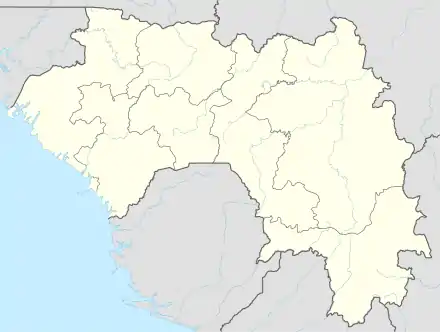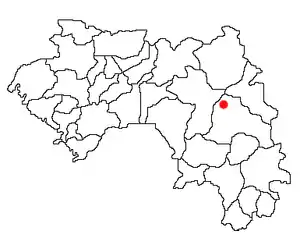Kankan
Kankan (Mandingo: Kánkàn; N’ko: ߞߊ߲ߞߊ߲߫) is the largest city in Guinea in land area, and the third largest in population, with a population of 198,013 people as of 2020.[3] The city is located in eastern Guinea about 555 kilometres (345 miles) east of the national capital Conakry.
Kankan | |
|---|---|
Sub-prefecture and town | |
.jpg.webp) Downtown Kankan | |
 Kankan | |
| Coordinates: 10°23′N 9°18′W | |
| Country | |
| Region | Kankan Region |
| Prefecture | Kankan Prefecture |
| Government | |
| • Mayor | Mory Kolofon Diakité[1] |
| Population (2020[2]) | |
| • Total | 198,013 |
The city is the capital and largest town of the Kankan Prefecture and of the Kankan Region with its population being largely from the Mande ethnic group.
The Kankan region now has more than 6,167,904 inhabitants (2021) which has made it the most populous region in Guinea. The region has five (5) prefectures (Kankan, Kérouané, Kouroussa, Mandiana and Siguiri), 53 sub-prefectures, 5 urban communes, 53 rural communes , 878 arrondissements, 68 neighborhoods and 1864 sectors.
Etymology
Kankan had different names (see History section) before being dubbed Kankan during Arafan Kabine's rule as patriarch, which means 'the defenses' (or 'God protect our city from all the attacks'), due to successives attacks by the unfaithful people.
But there are other terms which says that during the Kaba's negotiation of the place from Conde's, they were informed to install where the people made the Kankan (A fixed wood that Mandes often used as a door), and there were no other human settlement between Makonon and Diankana (30 km) during this moment.
The other terms are used by the griots, that there were too much of the Kankan-Kissè (an arborescent name) in to the area that Kankan settled in, so the Conde's told the Kaba to install this place, which made the Kaba to rename it as Kankan. Those terms have no sources and the speakers didn't know anything about Kankan's history.
Geography
The city is located on the Milo River, a tributary of the Niger River.
History
Early history
According to oral histories, Kankan was founded in 1690 by Daouda Kaba, who's ancestors had come from Diafounou, in what is now Mali, a few decades earlier. His uncle Fodemoudou Conde, chief of the nearby village Makonon, gave Kaba the land on the banks of the Milo river near where the bridge is today, which was open bush. The hamlet was originally called Fadou (place of plenty), then Kaourou (prosperous place), then Nabaya (place of welcome).[4]
Another tradition holds that Kankan was founded in the mid 17th century by Dyula traders of the Sarif and Sanyo families. By the 18th century it was an important religious center under the great marabout and Islamic scholar Alfa Kaabinè Kaba as well as a center of trade linking the coast, the kola nut growing regions, and the Niger river valley to the north.[5]: 41 During this period Kankan was the capital of the Bate Empire.[6]
In 1763 the warlord Bourama Diakite from Wassoulou drove the inhabitants of the Bate region, including Kankan, intto Fouta Jalon, where they took refuge in Timbo and Fougoumba due to their shared Islamic background. Their exile lasted seven years. Upon their return in 1770 they rebuilt and fortified the town and renamed it Kankan, meaning 'protected city'.[4] The new town was built in six districts, two of which were named after the towns that had sheltered their inhabitants during exile. Timbo neighborhood still exists today..
Another later invasion from Wassoulou, led by the kings Diédi and Djiba (or DJI), attempted to conquer Kankan but it was defeated by Alpha-Mamoudou Kaba..
The French explorer René Caillié spent a month in Kankan in 1827 during his journey from Boké, in present-day Guinea, to Djenné and Timbuktu in Mali. He arrived with a caravan transporting kola nuts. He described the visit in his book Travels through Central Africa to Timbuctoo. The town had a population of 6,000 inhabitants and was an important commercial centre with a market held three times a week. Instead of having a surrounding mud wall, the town was defended by quickset hedges. The chief of the town refused Caillié permission to travel along the river to the north as the town of Kankan was fighting for control of the Bouré gold producing area around Siguiri and the Tinkisso River. Instead Caillié left the town heading east in the direction of Minignan in the Ivory Coast.[7][8]
Alliance with Samori and conflict
After defeating Jamoro Aji and Ouorokodo Famoudou in the Battle of Saman-Saman, Kankan sent emissaries to join the theocratic alliance led by Samori Ture and signed the peace treaty with him.
While Samori was trying to conquering the Cissé kingdom, he called on Bate (Kankan) to help him, but Kankan categorically refused because one of the Séré-Bréma's wives, Mali Kaba, was from Kankan. Samori saw this as a betrayal, and in 1879 sent troops to besiege the town within three months. Mamadi Kaba (commonly known as Dayi Kaba) miraculously escaped the besieged city. During this siege, Karifamoudouya sent troops to break the siege over Kankan, but they were repelled and massacred until they crossed the River Gbourouroun, the border between two cities.. After having driven out the Kaba, Samori installed a puppet ruler. Kaba, meanwhile, joined the French colonial forces in Ségou, fighting with them until they captured Kankan in 1891, at which point the dynasty was restored.[9]
Colonial Era
In 1904, the city was chosen as the final destination for the railroad originating in Conakry. This was eventually completed in 1914, enhancing Kankan's longstanding position as a crossroads of trade. By 1922 it was widely seen as the second city of Guinea, after the capital Conkary.[9]
Climate
Kankan has a tropical savanna climate (Köppen climate classification Aw).
| Climate data for Kankan | |||||||||||||
|---|---|---|---|---|---|---|---|---|---|---|---|---|---|
| Month | Jan | Feb | Mar | Apr | May | Jun | Jul | Aug | Sep | Oct | Nov | Dec | Year |
| Average high °C (°F) | 36.5 (97.7) |
38.1 (100.6) |
38.9 (102.0) |
38.8 (101.8) |
37.1 (98.8) |
33.2 (91.8) |
32.2 (90.0) |
31.7 (89.1) |
32.7 (90.9) |
33.9 (93.0) |
34.7 (94.5) |
35.2 (95.4) |
35.3 (95.5) |
| Daily mean °C (°F) | 24.3 (75.7) |
26.3 (79.3) |
29.6 (85.3) |
30.1 (86.2) |
28.3 (82.9) |
26.4 (79.5) |
25.3 (77.5) |
25.1 (77.2) |
25.5 (77.9) |
26.4 (79.5) |
27.0 (80.6) |
23.8 (74.8) |
26.5 (79.7) |
| Average low °C (°F) | 10.8 (51.4) |
13.3 (55.9) |
17.0 (62.6) |
20.2 (68.4) |
19.6 (67.3) |
18.8 (65.8) |
18.9 (66.0) |
18.8 (65.8) |
18.9 (66.0) |
19.0 (66.2) |
13.9 (57.0) |
11.0 (51.8) |
16.7 (62.1) |
| Average rainfall mm (inches) | 2 (0.1) |
1 (0.0) |
24 (0.9) |
67 (2.6) |
134 (5.3) |
204 (8.0) |
262 (10.3) |
322 (12.7) |
304 (12.0) |
131 (5.2) |
20 (0.8) |
1.2 (0.05) |
1,472.2 (57.95) |
| Average rainy days (≥ 1.0 mm) | 1 | 1 | 3 | 6 | 11 | 15 | 19 | 22 | 21 | 13 | 3 | 1 | 116 |
| Average relative humidity (%) | 38 | 35 | 38 | 49 | 63 | 73 | 77 | 79 | 77 | 75 | 57 | 46 | 59 |
| Mean monthly sunshine hours | 262 | 236 | 249 | 220 | 234 | 216 | 169 | 159 | 191 | 221 | 241 | 260 | 2,658 |
| Source: NOAA[10] | |||||||||||||
Education
The Julius Nyerere University of Kankan was founded in 1964.
Places of worship

Among the places of worship, they are predominantly Muslim mosques. There are also Christian churches and temples : the Roman Catholic Diocese of Kankan (Catholic Church), Église Protestante Évangélique de Guinée (Alliance World Fellowship), Assemblies of God.[11]
Transports

It is home to the Kankan Airport and a river port. Kankan is the terminus of the lightduty narrow gauge railway from Conakry (traffic suspended since 1993). The N1 highway connects the city with Nzerekore in the south.
References
- "Commune de Kankan : Mory Kolofon Diakité du RPG élu maire !". conakryinfos.com (in French). 2018. Retrieved 5 November 2021.
- "Etat et Structure de la Population Recensement General de la Population et de l'habitation 2020" (PDF). Direction Nationale de la Statistique de Guinée (in French). Retrieved 27 March 2020.
- "Etat et Structure de la Population Recensement General de la Population et de l'habitation 2014" (PDF). Direction Nationale de la Statistique de Guinée (in French). Retrieved 27 March 2020.
- "Bref rappel historique de la fondation de la ville de Kankan par Daouda Kaba en 1690". KabaBachir.com. 20 Jan 2017. Retrieved 21 July 2023.
- Massing, Andrew (1985). "The Mane, the Decline of Mali, and Mandinka Expansion towards the South Windward Coast" (PDF). Cahiers d'Études Africaines. 25 (97): 21–55. Retrieved 16 July 2023.
- Camara, Mohamed Saliou (29 May 2020). "The History of Guinea". Oxford Research Encyclopedias. Oxford, Oxfordshire: Oxford University Press. doi:10.1093/acrefore/9780190277734.013.626. ISBN 978-0-19-027773-4. Retrieved 21 July 2023.
- Caillié, René (1830). Travels through Central Africa to Timbuctoo; and across the Great Desert, to Morocco, performed in the years 1824-1828 (Volume 1). London: Colburn & Bentley. pp. 254–286.
- Quella-Villéger, Alain (2012). René Caillié, l'Africain : une vie d'explorateur, 1799-1838 (in French). Anglet, France: Aubéron. pp. 71–75. ISBN 978-2-84498-137-0.
- Page, Willie F. (2005). Davis, R. Hunt (ed.). Encyclopedia of African History and Culture. Vol. IV (Illustrated, revised ed.). Facts On File. p. 201.
- "Kankan Climate Normals 1961–1990". National Oceanic and Atmospheric Administration. Retrieved July 6, 2015.
- J. Gordon Melton, Martin Baumann, ‘‘Religions of the World: A Comprehensive Encyclopedia of Beliefs and Practices’’, ABC-CLIO, USA, 2010, p. 1279
